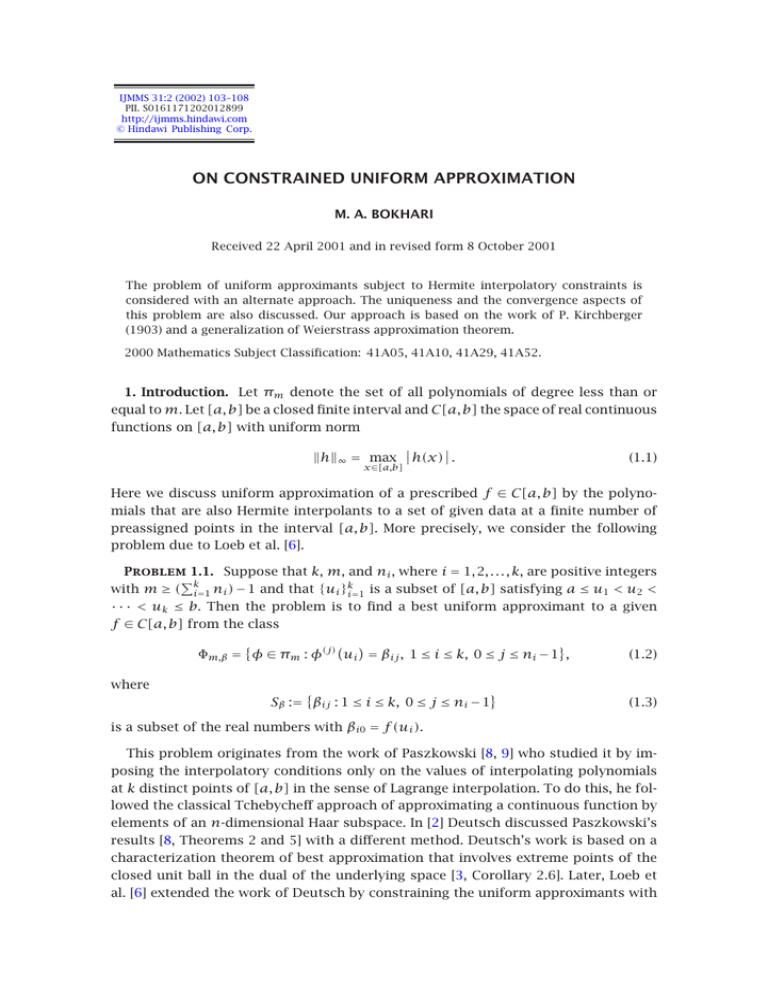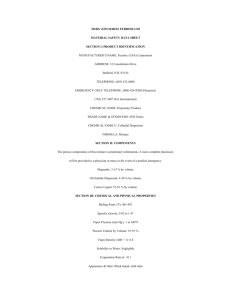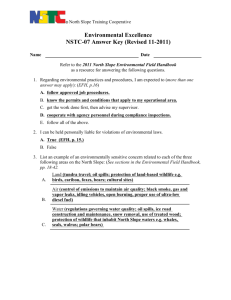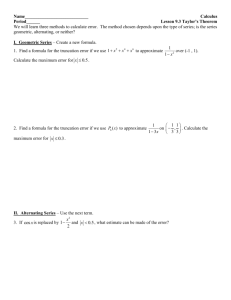ON CONSTRAINED UNIFORM APPROXIMATION M. A. BOKHARI
advertisement

IJMMS 31:2 (2002) 103–108
PII. S0161171202012899
http://ijmms.hindawi.com
© Hindawi Publishing Corp.
ON CONSTRAINED UNIFORM APPROXIMATION
M. A. BOKHARI
Received 22 April 2001 and in revised form 8 October 2001
The problem of uniform approximants subject to Hermite interpolatory constraints is
considered with an alternate approach. The uniqueness and the convergence aspects of
this problem are also discussed. Our approach is based on the work of P. Kirchberger
(1903) and a generalization of Weierstrass approximation theorem.
2000 Mathematics Subject Classification: 41A05, 41A10, 41A29, 41A52.
1. Introduction. Let πm denote the set of all polynomials of degree less than or
equal to m. Let [a, b] be a closed finite interval and C[a, b] the space of real continuous
functions on [a, b] with uniform norm
h∞ = max h(x).
x∈[a,b]
(1.1)
Here we discuss uniform approximation of a prescribed f ∈ C[a, b] by the polynomials that are also Hermite interpolants to a set of given data at a finite number of
preassigned points in the interval [a, b]. More precisely, we consider the following
problem due to Loeb et al. [6].
Problem 1.1. Suppose that k, m, and ni , where i = 1, 2, . . . , k, are positive integers
k
with m ≥ ( i=1 ni ) − 1 and that {ui }ki=1 is a subset of [a, b] satisfying a ≤ u1 < u2 <
· · · < uk ≤ b. Then the problem is to find a best uniform approximant to a given
f ∈ C[a, b] from the class
where
Φm,β = φ ∈ πm : φ(j) ui = βij , 1 ≤ i ≤ k, 0 ≤ j ≤ ni − 1 ,
(1.2)
Sβ := βij : 1 ≤ i ≤ k, 0 ≤ j ≤ ni − 1
(1.3)
is a subset of the real numbers with βi0 = f (ui ).
This problem originates from the work of Paszkowski [8, 9] who studied it by imposing the interpolatory conditions only on the values of interpolating polynomials
at k distinct points of [a, b] in the sense of Lagrange interpolation. To do this, he followed the classical Tchebycheff approach of approximating a continuous function by
elements of an n-dimensional Haar subspace. In [2] Deutsch discussed Paszkowski’s
results [8, Theorems 2 and 5] with a different method. Deutsch’s work is based on a
characterization theorem of best approximation that involves extreme points of the
closed unit ball in the dual of the underlying space [3, Corollary 2.6]. Later, Loeb et
al. [6] extended the work of Deutsch by constraining the uniform approximants with
104
M. A. BOKHARI
Hermite interpolatory conditions. In fact, they discussed Problem 1.1 through the notions of the n-dimensional extended Haar subspace of order ν of C[a, b] (see [4]) and
the generalized weight functions (see [7]). They also established a convergence result
by giving a generalization of a theorem of de La Vallée Poussin [1, page 77].
In the present paper we continue the study of Problem 1.1. Our approach for its
solution is based on the work of Kirchberger [5] that deals with extreme values of the
error function. Uniqueness and convergence problems are also addressed in our work
taking into account an extension of Weierstrass approximation theorem [10].
2. Notations and reformulation of Problem 1.1. For the sake of convenience, we
set Ik := {1, 2, . . . , k}, Ni := {0, 1, . . . , ni − 1}, s := i∈Ik ni , and
W (x) :=
n
x − ui i .
(2.1)
i∈Ik
The notation Hs−1 (x, Sβ ), where Sβ is given in (1.3), stands for the polynomial of degree
less than or equal to s − 1 that satisfies the following conditions:
(j) Hs−1 ui , Sβ = βij ,
∀i ∈ Ik , ∀j ∈ Ni .
(2.2)
For every f ∈ C[a, b], we define
fH,β (x) := f (x) − Hs−1 x, Sβ .
(2.3)
The error function corresponding to f , g ∈ C[a, b] and the set of its extreme points
in [a, b] will be denoted, respectively, as follows:
ef ,g (x) := f (x) − g(x),
crit ef ,g := x ∈ [a, b] : ef ,g (x) = ef ,g ∞ .
(2.4)
∗
denote the (m − s + 1)-dimensional subspace of πm generated by the polynoLet πm
mials x j W (x), j = 0, 1, 2, . . . , m − s, where W is given by (2.1). The following remark
gives an explicit representation of the elements of Φm,β (see (1.2)).
Remark 2.1. A typical element φ∗ in the approximating class Φm,β is of the form
φ∗ (x) = Hs−1 x, Sβ + q∗ (x),
(2.5)
∗
where q∗ ∈ πm
. This shows that φ∗ ∈ Φm,β is a best approximant to f from the
∗
∗
class Φm,β if and only if q∗ ∈ πm
is a best approximant to fH,β from the class πm
. In
particular, if m = s − 1 then Hs−1 (x, Sβ ) will be the best approximation to f . For this
obvious reason we assume that m ≥ s in the rest of the paper.
In view of the above remark, Problem 1.1 can be reformulated as follows.
Problem 2.2. For a given function f ∈ C[a, b], find a best approximation to fH,β
∗
(see (2.3)) in the uniform norm from the class πm
.
ON CONSTRAINED UNIFORM APPROXIMATION
105
3. Characterization of best approximation. This section deals with a necessary
∗
can
and sufficient condition for a solution of Problem 2.2. We note that every q ∈ πm
be expressed as
(3.1)
q(x) = W (x)Rq (x),
∗
,
where Rq (x) is a polynomial of degree at most m−s. For an f ∈ C[a, b] and a q ∈ πm
we set
fH,β (x)
(3.2)
EfH,β ,q (x) :=
− Rq (x).
W (x)
An alternate form of the characterization theorem [6, Theorem 3.1] that solves
Problem 1.1 may be stated as follows.
∗
. Then q∗ is a best uniform apTheorem 3.1. Let f ∈ C[a, b] such that fH,β ∉ πm
∗
proximant to fH,β from the class π if and only if there exist N points αi ∈ crit(efH,β ,q∗ )
satisfying the following conditions:
(a) N = m − s + 2;
(b) a ≤ α1 < α2 < · · · < αN ≤ b;
(c) sgn(EfH,β ,q∗ (αi )) = (−1)i+1 sgn(EfH,β ,q∗ (α1 )), for all i = 2, 3, . . . , N.
Our method of proof is based on the following lemma which may be found in the
standard texts of approximation theory, for example, [9, Lemma 7.1].
Lemma 3.2. Let Y be a linear subspace of C[a, b] and let h ∈ C[a, b]. Then g ∗ ∈ Y
is a best uniform approximant to f in Y if and only if there does not exist any g ∈ Y
such that
(3.3)
h(x) − g ∗ (x) g(x) > 0
for all x ∈ crit(ef ,g∗ ) (see (2.3)).
∗
and h = fH,β in the above lemma, then the necessary
Remark 3.3. If we set Y = πm
∗
∗
and sufficient condition for q ∈ πm
to be a best approximation to fH,β is that there
∗
such that
does not exist any p ∈ πm
EfH,β ,q∗ (x)Rp (x) > 0
(3.4)
for all x ∈ crit(efH,β ,q∗ ) where Rp (x) and EfH,β ,q∗ are, respectively, given in (3.1) and
(3.2). To justify this, it is enough to note that
fH,β (x) − q∗ (x) p(x) = EfH,β ,q∗ (x)Rp (x)W 2 (x).
(3.5)
∗
Remark 3.4. If fH,β ∉ πm
, then W (x) is a nonvanishing function on the compact
∗
. Consequently, fH,β is continuous
set crit(efH,β ,p ) regardless of the choice of p ∈ πm
as well as nowhere zero on crit(efH,β ,p ).
4. Proof of Theorem 3.1. If q∗ is not a best approximation to fH,β , then by Remark
∗
such that
3.3, there exists p ∈ πm
EfH,β ,q∗ (x)Rp (x) > 0
(4.1)
as x ranges over crit(efH,β ,q∗ ). We note that Rp being a polynomial of degree less than
or equal to m −s (see (3.1)) changes sign at most at m −s places. Therefore, it follows
106
M. A. BOKHARI
from (4.1) that EfH,β ,q∗ (x) cannot change sign more than (m − s) times as x ranges
over crit(efH,β ,q∗ ). This contradicts Theorem 3.1(c) as N = m − s + 2.
Conversely, assume that there are N points αi ∈ crit(efH,β ,q∗ ), i = 1, 2, . . . , N, satisfying Theorem 3.1(b) and (c) but N ≤ m−s +1. For each i = 1, 2, 3, . . . , N −1, fix a point
wi ∈ (αi , αi+1 ) such that
uj ∉ wi , αi+1 , j = 1, 2, . . . , k,
wi , αi+1 , crit efH,β ,q∗ are disjoint,
sgn EfH,β ,q∗ wi = sgn EfH,β ,q∗ αi+1 .
(4.2)
The choice of wi , as required above, directly follows from Remark 3.4. Now we set
N−1
wi − x .
p(x)
:= sgn EfH,β ,q∗ α1 W (x)
(4.3)
i=1
∗
∈ πm
with Rp (x) = sgn(EfH,β ,q∗ (α1 ))
Then p
EfH,β ,q∗ (α)Rp (α) > 0
N−1
i=1
(wi − x). We claim that
∀α ∈ crit efH,β ,q∗ .
(4.4)
This can be seen by restricting α to each set (αi , αi+1 ]∩crit(efH,β ,q∗ ) for i = 0, 1, . . . , N −
1, where α0 = a, and then using Theorem 3.1(c) along with (4.2). Hence by Remark 3.3,
∗
. This
we note that q∗ cannot be a best uniform approximant to fH,β from the class πm
completes the proof.
Remark 4.1. An immediate consequence of Theorem 3.1 is that Hs−1 (x, Sβ ) +
q∗ (x) is a best uniform approximant to f (x) from the class Φm,β .
5. Uniqueness. We retain the setting of the previous sections in order to establish
the uniqueness of the solution of Problem 2.2. More precisely, we prove the following
theorem.
∗
.
Theorem 5.1. There is exactly one best uniform approximant p ∗ to fH,β from πm
∗
, then there exist N points
If q∗ is another best uniform approximant to fH,β from πm
αi ∈ crit(efH,β ,q∗ ), i = 1, 2, . . . , N, satisfying Theorem 3.1(a), (b), and (c). Using the properties of best approximant to fH,β , we observe that |fH (αi ) − p ∗ (αi )| ≤ efH,β ,p∗ ∞ =
efH,β ,q∗ ∞ = |fH,β (αi ) − q∗ (αi )| for each i = 1, 2, . . . , N, and consequently,
Ef ,p∗ αi ≤ Ef ,q∗ αi .
H,β
H,β
(5.1)
We set D(x) := Rp∗ (x) − Rq∗ (x). Then D ∈ πm−s and
D αi = EfH,β ,q∗ αi − EfH,β ,p∗ αi ,
i = 1, 2, . . . , N.
(5.2)
Note that if D(αi )≠0 for any i=1, 2, . . . , N, then by (5.2), sgn(D(αi )) = sgn(EfH,β ,q∗ (αi )).
Thus, the polynomial D has either a double zero at αi , or it has a zero in (αi , αi+1 )
implying that D ≡ 0. Hence Rp∗ (x) = Rq∗ (x), and consequently, p ∗ = q∗ .
107
ON CONSTRAINED UNIFORM APPROXIMATION
6. Convergence. In this section, we discuss the convergence of the sequence of
best uniform approximants {qk∗ }∞
k=s−1 to fH,β with the conditions that f is sufficiently
differentiable and the set Sβ (see Problem 1.1) is replaced by
Sf = f (j) ui : j ∈ Ni , i ∈ Ik .
(6.1)
In this case, we write fH,f and Φm,f instead of fH,β and Φm,β (see (2.3)).
∗
Theorem 6.1. Assume that f ∈ C n [a, b] with n∗ = (max i∈Ik ni ) − 1 and that the
∗
∗
∈ πm
is the best approximant to fH,f in the
set Sβ (see (1.3)) is replaced by Sf . If qm
sense of Theorem 3.1, then
∗
− fH,f ∞ = 0.
(6.2)
lim qm
m→∞
Consequently, the sequence
∗
{qm
+ Hs−1 (·, Sf )}∞
m=s−1
will converge uniformly to f .
The crux of the proof of this theorem is in an extension of a result based on the
Weierstrass approximation theorem [10, page 160]. We state it in the next lemma
without proof as it is a routine exercise.
Lemma 6.2. For any f ∈ C r [a, b], and for a given ε > 0, there exists a polynomial
p such that
(j)
f − p (j) < ε
(6.3)
∞
for all j = 0, 1, 2, . . . , r .
Proof of Theorem 6.1. In the notations of (2.3) and (6.1), we can write
fH,f (x) := f (x) − Hs−1 x, Sf .
(6.4)
The polynomial Hs−1 (x, Sf ) due to its interpolation properties may be expressed as
(n) f
(6.5)
Hs−1 x, Sf =
ul Ln,l (x),
l∈Ik n∈Nl
where Ln,l (x) are the fundamental polynomials of degree s − 1 satisfying the conditions
1 for l = i, n = j,
(j) Ln,l ui =
(6.6)
0 otherwise.
For a given ε > 0, we can fix a polynomial p of degree r > s such that (see Lemma 6.2)
(j)
f − p (j) < ε , j = 0, 1, . . . , n∗ ,
(6.7)
∞
2τ
where τ = max{1, λ} with λ = max x∈[a,b] l∈Ik n∈Nl |Ln,l (x)|. From (6.1), (6.5), and
(6.7) it follows that
ε
max Hs−1 x, Sf − Hs−1 x, Sp < .
2
x∈[a,b]
(6.8)
We set q(x) := p(x) − Hs−1 (x, Sp ). Then q ∈ πr and q(j) (ui ) = 0 for j ∈ Ni and i ∈ Ik .
Hence, W as defined in (2.1) is a factor of the polynomial q. This shows that q ∈ πr∗ .
Using (6.4), (6.5), and (6.8) it can be seen that
fH,f − q < ε.
(6.9)
∞
108
M. A. BOKHARI
Now consider the best uniform approximant qr∗ to fH from πr∗ (see Theorem 3.1) and
note that
∗
(6.10)
ε > fH,f − q∞ ≥ fH,f − qr∗ ∞ ≥ fH,f − qm
∞
∗
for all m ≥ r . The last inequality follows from the relation πr∗ ⊆ πm
. This proves the
desired result.
Acknowledgment. The author acknowledges with gratitude the research facilities available at King Fahd University of Petroleum and Minerals, Saudi Arabia, and
the University of Alberta, Canada, during the preparation of this paper.
References
[1]
[2]
[3]
[4]
[5]
[6]
[7]
[8]
[9]
[10]
E. W. Cheney, Introduction to Approximation Theory, McGraw-Hill, New York, 1966.
F. Deutsch, On uniform approximation with interpolatory constraints, J. Math. Anal. Appl.
24 (1968), 62–79.
F. R. Deutsch and P. H. Maserick, Applications of the Hahn-Banach theorem in approximation theory, SIAM Rev. 9 (1967), 516–530.
S. Karlin and W. J. Studden, Tchebycheff Systems: With Applications in Analysis and Statistics, Pure and Applied Mathematics, vol. 15, Interscience Publishers, New York,
1966.
P. Kirchberger, Über Tchebychefsche annäherungsmethoden, Math. Ann. 57 (1903), 509–
540 (German).
H. L. Loeb, D. G. Moursund, L. L. Schumaker, and G. D. Taylor, Uniform generalized
weight function polynomial approximation with interpolation, SIAM J. Numer. Anal.
6 (1969), 284–293.
D. G. Moursund, Chebyshev approximation using a generalized weight function, SIAM J.
Numer. Anal. 3 (1966), 435–450.
S. Paszkowski, Sur l’approximation uniforme avec des noeuds, Ann. Polon. Math. 2 (1955),
118–135 (French).
, On approximation with nodes, Rozprawy Mat. 14 (1957), 63.
T. J. Rivlin, The Chebyshev Polynomials, Pure and Applied Mathematics, John Wiley &
Sons, New York, 1974.
M. A. Bokhari : Department of Mathematical Sciences, King Fahd University of Petroleum and Minerals, Dhahran 31261, Saudi Arabia
E-mail address: mbokhari@kfupm.edu.sa







